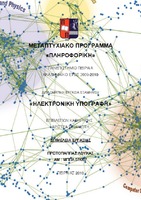Ηλεκτρονική υπογραφή

Master Thesis
Author
Πρωτόπαππας, Λουκάς
Date
2011-07-13View/
Subject
Κρυπτογραφία ; Ψηφιακές υπογραφές ; Ψηφιακές υπογραφές -- Δίκαιο και νομοθεσία ; Ηλεκτρονικό δίκαιοAbstract
The development of internet, electronic commerce and transactions over open networks make urgent need for security in transactions. The user who does business online requires data (e.g. a message or a text) that sends cannot be disclosed or made available to unauthorized people about it (confidentiality). The data should not be altered during transmission. The recipient should take them exactly as the sender and sent them to be sure that the data they receive is what the sender sent (integrity). Moreover, such a transaction, the recipient needs to be sure of the identity of the sender (authenticity). The need for confidentiality in the electronic transaction satisfied with the cryptography. The sender using some mathematical function transforms the original text as incomprehensible to anyone else (cipher text). The use of electronic signature includes two processes: the signature and verification. Below, you say step by step the actions the sender and the recipient to understand the mechanism of creating and verifying digital signatures. Upon receiving a message with electronic signature, the recipient by verifying an electronic signature certifying that the message is intact. The recipient to verify the electronic signature using public key of the sender. Presidential decree 150/2000, which harmonized EU Directive 99/93/EC of the European Parliament and Council on a Community framework for electronic signatures that set the framework within which a digital signature is legally recognized as a manuscript. This means that under certain conditions, persons involved in an electronic transaction and electronic sign, cannot refuse.


